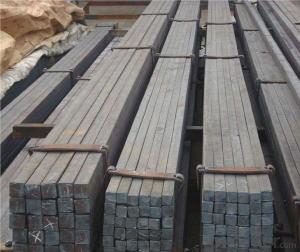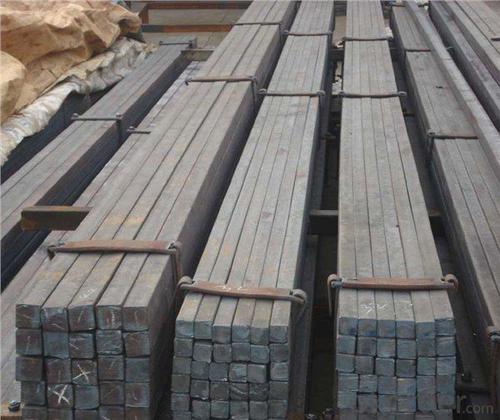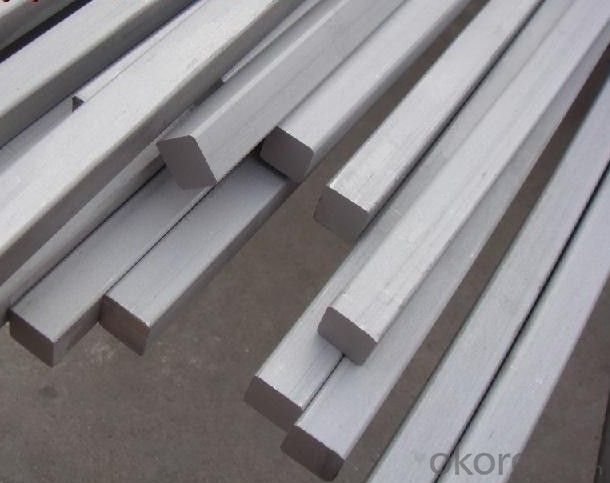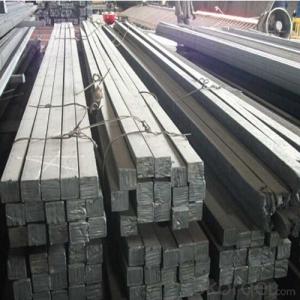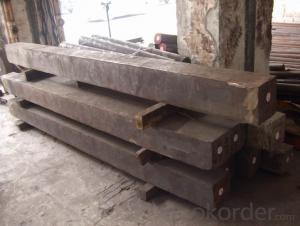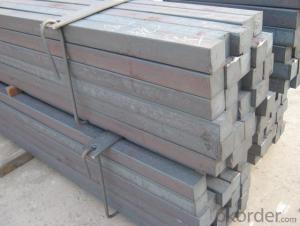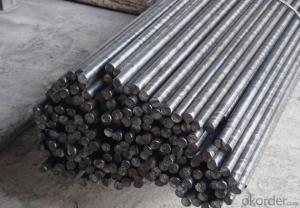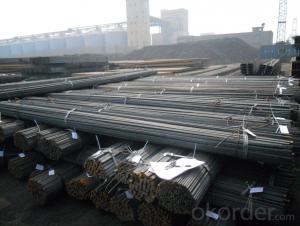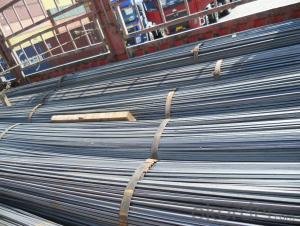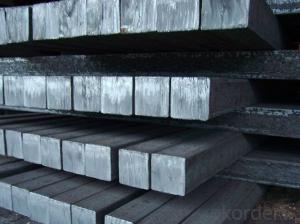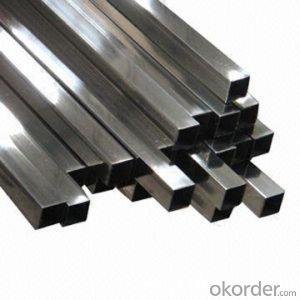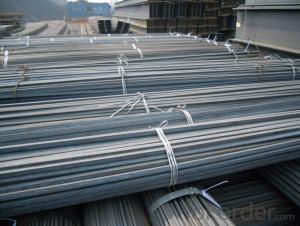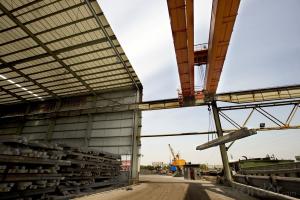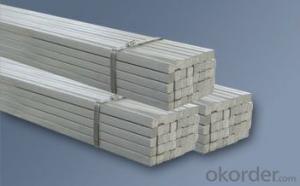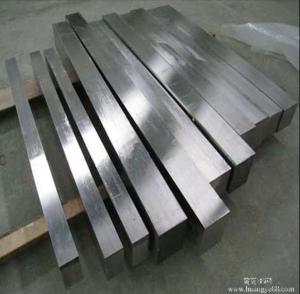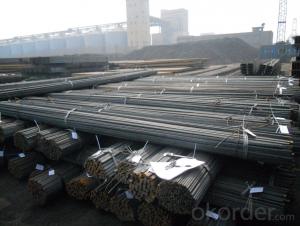Hot Rolled Square Steel Bar Q235, SAE1020, SAE1045
- Loading Port:
- Shanghai
- Payment Terms:
- TT or LC
- Min Order Qty:
- 25 m.t.
- Supply Capability:
- 200000 m.t./month
OKorder Service Pledge
OKorder Financial Service
You Might Also Like
Product Description:
OKorder is offering Hot Rolled Square Steel Bar Q235, SAE1020, SAE1045 at great prices with worldwide shipping. Our supplier is a world-class manufacturer of steel, with our products utilized the world over. OKorder annually supplies products to European, North American and Asian markets. We provide quotations within 24 hours of receiving an inquiry and guarantee competitive prices.
Product Applications:
Hot Rolled Square Steel Bar Q235, SAE1020, SAE1045 are ideal for structural applications and are widely used in the construction of buildings and bridges, and the manufacturing, petrochemical, and transportation industries.
-The Square Steel is normally used as structure steel.
-Row material for other structure steel like steel angles, channels, I-beams, H-beams, etc…
Product Advantages:
OKorder's Hot Rolled Square Steel Bar Q235, SAE1020, SAE1045 are durable, strong, and resist corrosion.
Main Product Features:
· Premium quality
· Prompt delivery & seaworthy packing (30 days after receiving deposit)
· Corrosion resistance
· Can be recycled and reused
· Mill test certification
· Professional Service
· Competitive pricing
Product Description:
Specifications of High Quality Square Steel Bar Q235, SAE1020:
-Standard: GB,
-Grade: Q195/Q235 or equivalent.
Chemical Composition:
-Chemical Composition. Q195
Standard | Grade | Element (%) | ||||
GB | Q195 | C | Mn | S | P | Si |
0.06~0.12 | 0.25~0.50 | ≤0.050 | ≤0.045 | ≤0.30 | ||
-Chemical Composition. Q235
Standard | Grade | Element (%) | ||||
GB | Q235B | C | Mn | S | P | Si |
0.12~0.20 | 0.30~0.70 | ≤0.045 | ≤0.045 | ≤0.30 | ||
Measures and Tolerances of Square Steel Bar:
(The section of Square Steel Bar)
-The length of a side and the theoretical weight of Square Steel.
Length of a side(a, mm) | Theoretical weight(kg/m) | Length of a side(a, mm) | Theoretical weight(kg/m) |
6 | 0.283 | 32 | 8.04 |
7 | 0.385 | *33 | 8.55 |
8 | 0.502 | 34 | 9.07 |
9 | 0.636 | *35 | 9.62 |
10 | 0.785 | 36 | 10.17 |
11 | 0.950 | 38 | 11.24 |
12 | 1.13 | 40 | 12.56 |
13 | 1.33 | 42 | 13.85 |
14 | 1.54 | 45 | 15.90 |
15 | 1.77 | 48 | 18.09 |
16 | 2.01 | 50 | 19.63 |
17 | 2.27 | 53 | 22.05 |
18 | 2.54 | *55 | 23.6 |
19 | 2.82 | 56 | 24.61 |
20 | 3.14 | *58 | 26.4 |
21 | 3.46 | 60 | 28.26 |
22 | 3.80 | 63 | 31.16 |
*23 | 4.15 | *65 | 33.17 |
24 | 4.52 | *68 | 36.3 |
25 | 4.91 | 79 | 38.49 |
26 | 5.30 | 75 | 44.16 |
*27 | 5.72 | 80 | 50.24 |
28 | 6.15 | 85 | 56.72 |
*29 | 6.60 | 90 | 63.59 |
30 | 7.06 | 95 | 70.85 |
*31 | 7.54 | 100 | 78.50 |
Notes:
1, The theoretical weights in the list, base on the density of 7.85 g/cm3.
2, The numbers with *mean that they are not regulars or we don’t offer them.
-The allowed tolerance of Square Steel:
Length of a side(mm) | Allowed Tolerance | ||
Group1 | Group2 | Group3 | |
5.5~7 | ±0.20 | ±0.30 | ±0.40 |
7~20 | ±0.25 | ±0.35 | ±0.40 |
20~30 | ±0.30 | ±0.40 | ±0.50 |
30~50 | ±0.40 | ±0.50 | ±0.60 |
60~80 | ±0.60 | ±0.70 | ±0.80 |
80~110 | ±0.90 | ±1.0 | ±1.1 |
110~150 | ±1.2 | ±1.3 | ±1.1 |
150~190 | ―― | ―― | ±2.0 |
190~250 | ―― | ―― | ±2.5 |
Packaging & Delivery of Hot Rolled Square Steel Bar Q235, SAE1020, SAE1045:
-Packing Detail: The products can be packed in bundles by steel wires.
-Marks:
1, Tag marks: the tag marks will be tied up to each bundle of the products. The information is usually including supplier’s logo and name, product name, made in China, products’ specifications, the painted color and other information requested by customers.
2, Color marks: we will paint both ends of the bundles of these products to make sure that they are more evident. It’s will be more convenient for the customers to distinguish them at the destination port.
-Delivery Detail: 30~45 working days after receive buyer’s T.T. or L/C.
Transportation:
-The products can be delivered by bulk vessel or by container. As for container, products with the length of 6m will be loaded in 20’ container, with 9m or 12m, in 40’ container.
-The maximum quantity of loading of container is 25 tons.
-The products usually are transported to the nearest port from the production place.
Payment:
-Invoicing on theoretical weight or actual weight a s customer’s request.
-FOB, CFR or CIF.
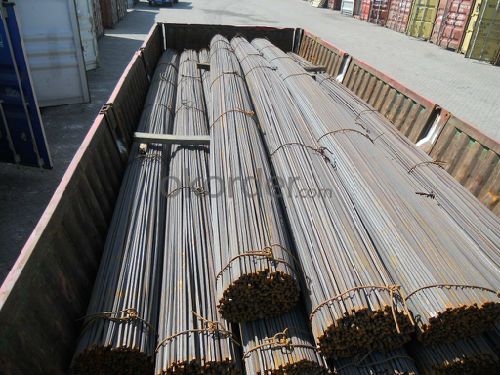
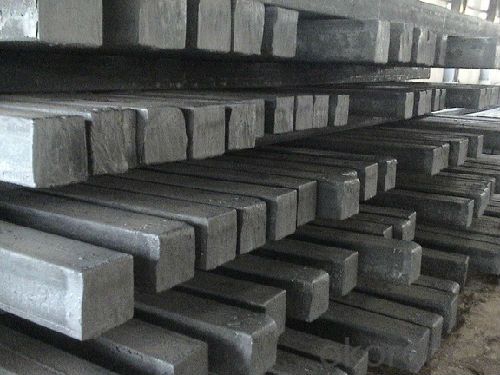
FAQ:
Q1: How soon can we receive the product after purchase?
A1: Within three days of placing an order, we will begin production. The specific shipping date is dependent upon international and government factors, but is typically 7 to 10 workdays.
Q2: The products are invoicing on theoritical weight or on actual weight?
A2: We can do it in both manners, according to the customers' request.
Q3: How do we guarantee the quality of our products?
A3: We have established an advanced quality management system which conducts strict quality tests at every step, from raw materials to the final product. At the same time, we provide extensive follow-up service assurances as required.
- Q: Are steel squares resistant to rust and corrosion?
- Yes, steel squares are generally resistant to rust and corrosion due to their composition and protective coatings.
- Q: Can a steel square be used for checking the squareness of a table saw blade?
- No, a steel square is not suitable for checking the squareness of a table saw blade. A specialized tool known as a dial indicator or a precision square is recommended for this task as it provides more accurate and reliable measurements.
- Q: Can a steel square be used for marking out half-lap joints?
- Marking out half-lap joints can be done with a steel square. A steel square, also known as a framing square or carpenter's square, is a versatile woodworking tool used for measuring and marking angles and lines. It consists of a long arm called the blade and a shorter arm called the tongue, which are perpendicular to each other. To mark a half-lap joint with a steel square, the woodworker starts by determining the width of the joint and marking it on one piece of wood's edge. Next, they align the blade of the steel square with the marked line and draw a line across the wood's face. This process is repeated on the other piece of wood that will form the joint, ensuring that the lines align properly for a tight fit. The steel square's accuracy and precision make it ideal for marking out half-lap joints. It allows for consistent and symmetrical lines, resulting in strong and well-fitting joints. However, it's important to note that the steel square is just one tool in the process of creating a half-lap joint. Other tools, such as a saw and chisel, are also necessary to complete the joint.
- Q: Can a steel square be used for checking the squareness of a wall?
- Yes, a steel square can be used for checking the squareness of a wall. A steel square is a versatile measuring tool that is commonly used in carpentry and construction. It consists of a flat, triangular blade with various measurements and angles marked on it. To check the squareness of a wall, you can place the steel square against the corner of the wall, ensuring that one edge is aligned with the vertical surface and the other edge is aligned with the horizontal surface. By doing this, you can assess if the corner is perfectly square or if it deviates from a right angle. If the wall is perfectly square, the steel square will fit snugly against both surfaces, and the right angle formed by the corner will be accurately reflected by the tool. However, if the wall is not square, you may notice a gap between the steel square and one or both surfaces, indicating that the corner is not at a perfect 90-degree angle. Using a steel square is a quick and efficient way to check the squareness of a wall during construction or renovation projects. It ensures that corners are properly aligned and can help identify any issues early on, allowing for necessary adjustments to be made.
- Q: What are some common uses of a steel square in metalworking sculpture?
- The steel square, also referred to as a framing square or a carpenter's square, serves multiple purposes in metalworking sculpture. It is a versatile tool commonly utilized for various tasks. Some of the common applications encompass: 1. Layout and marking: When working with metal sheets or other materials, the steel square plays a vital role in marking and laying out precise measurements. It facilitates the creation of straight lines, right angles, and accurate measurements. This ensures that the sculpture maintains proper alignment and symmetry. 2. Squareness verification: Metalworking sculptures often necessitate precise angles and right-angled corners. The steel square permits sculptors to verify squareness, guaranteeing perfect alignment of all corners and edges. This prevents distortions or irregularities in the final piece. 3. Measurement and dimension transfer: Metalworking sculptures require precise measurements for cutting, shaping, and joining various components. The steel square enables sculptors to measure and transfer dimensions accurately, ensuring the correct sizing and fit of different parts of the sculpture. 4. Miter cut creation: Miter cuts, which involve angled cuts made on the ends of metal pieces to create clean and tight joints, are a common technique in metalworking sculpture. The steel square aids in marking and cutting precise angles, facilitating seamless connections between different metal elements. 5. Flatness verification: The steel square can be employed to check the flatness of metal surfaces, ensuring they are level and even. This is particularly crucial when working with large metal sheets or when joining different components, as any unevenness can impact the overall stability and appearance of the sculpture. 6. Parallel line creation: Achieving symmetry or guiding the placement of various elements often requires parallel lines in metalworking sculpture. The steel square allows sculptors to effortlessly create parallel lines, ensuring uniformity and balance in the design. In conclusion, the steel square is an indispensable tool in metalworking sculpture. It aids artists and craftsmen in achieving precision, accuracy, and consistency in their work.
- Q: Can a steel square be used for roofing projects?
- Yes, a steel square can be used for roofing projects. A steel square, also known as a framing square or carpenter's square, is a versatile tool that can be used for a variety of tasks in construction and carpentry, including roofing. It is commonly used for measuring, marking, and cutting angles in roof framing, as well as determining pitch and slope. With its right angles and various measurements, a steel square can help ensure accurate and precise cuts and measurements during roofing projects. Additionally, steel squares are typically durable and resistant to corrosion, making them suitable for outdoor use in roofing applications.
- Q: Can a steel square be used for deck railing layout and installation?
- Yes, a steel square can be used for deck railing layout and installation. A steel square is a versatile tool that provides accurate angles and measurements, making it suitable for ensuring precise and proper installation of deck railings.
- Q: The steel structure material can do?
- First of all, will cause the waste of steel using square large section case, increase the weight of the structure, which is contrary to the steel structure of light weight advantages, small cross section from the processing, production process, the use of steel will be more, in addition to the special requirements, do not recommend the use of square steel.
- Q: How do you use a steel square to determine the angle of a roof truss?
- To use a steel square to determine the angle of a roof truss, you would need to follow these steps: 1. Start by placing the steel square against the edge of the truss where the angle needs to be measured. Make sure the square is aligned properly and securely against the truss. 2. Take note of the scale on the steel square. This scale usually consists of numbers and lines that represent degrees. The most common steel square has scales for measuring 90 degrees, 45 degrees, and 30 degrees. 3. Locate the line on the scale that corresponds to the desired angle you are trying to measure. For example, if you want to determine the angle of a truss that is 30 degrees, find the line on the scale that reads 30 degrees. 4. Next, align the line on the steel square that corresponds to the desired angle with the edge of the truss. This line should be parallel to the truss edge. 5. Once the line on the steel square is aligned with the truss edge, check the other side of the square. There should be another line or edge that intersects with the truss. This intersecting point will give you the angle measurement. 6. Read the angle measurement directly from the scale on the steel square at the intersecting point. This will give you the exact angle of the roof truss. Remember to ensure that the steel square is properly aligned and securely positioned against the truss to get accurate measurements. Additionally, it is essential to use the correct scale on the steel square that matches the desired angle you are trying to determine.
- Q: Can a steel square be used for checking the alignment of a fence?
- A fence's alignment can indeed be checked using a steel square. This versatile tool, also referred to as a framing square or carpenter's square, serves multiple purposes in the field of carpentry and construction. It comprises a lengthy blade and a shorter tongue, creating a right angle and featuring measurement markings along both sides. In order to verify the alignment of a fence, a steel square can be utilized to guarantee that the posts and rails are appropriately perpendicular to one another. This is crucial for upholding the fence's structural integrity and stability. To begin, position the steel square against one of the fence posts, ensuring that the blade aligns with the post while the tongue extends along the rail. Verify whether the square is flush against both the post and rail. If it is not, proceed to make adjustments to align them properly. Subsequently, employ a level to determine if the square is truly vertical. If the bubble in the level is centered, it indicates that the fence post is plumb. If it is not centered, make the necessary adjustments to the post until it achieves perfect verticality. Repeat this procedure for each fence post and rail to guarantee that the entire fence maintains proper alignment. Utilizing a steel square can assist you in achieving a fence that is straight and level, thereby enhancing both its functionality and aesthetic appeal.
Send your message to us
Hot Rolled Square Steel Bar Q235, SAE1020, SAE1045
- Loading Port:
- Shanghai
- Payment Terms:
- TT or LC
- Min Order Qty:
- 25 m.t.
- Supply Capability:
- 200000 m.t./month
OKorder Service Pledge
OKorder Financial Service
Similar products
Hot products
Hot Searches
Related keywords
